BMW M3 CONVERTIBLE 2001 E46 Manual PDF
Manufacturer: BMW, Model Year: 2001, Model line: M3 CONVERTIBLE, Model: BMW M3 CONVERTIBLE 2001 E46Pages: 195, PDF Size: 1.96 MB
Page 71 of 195
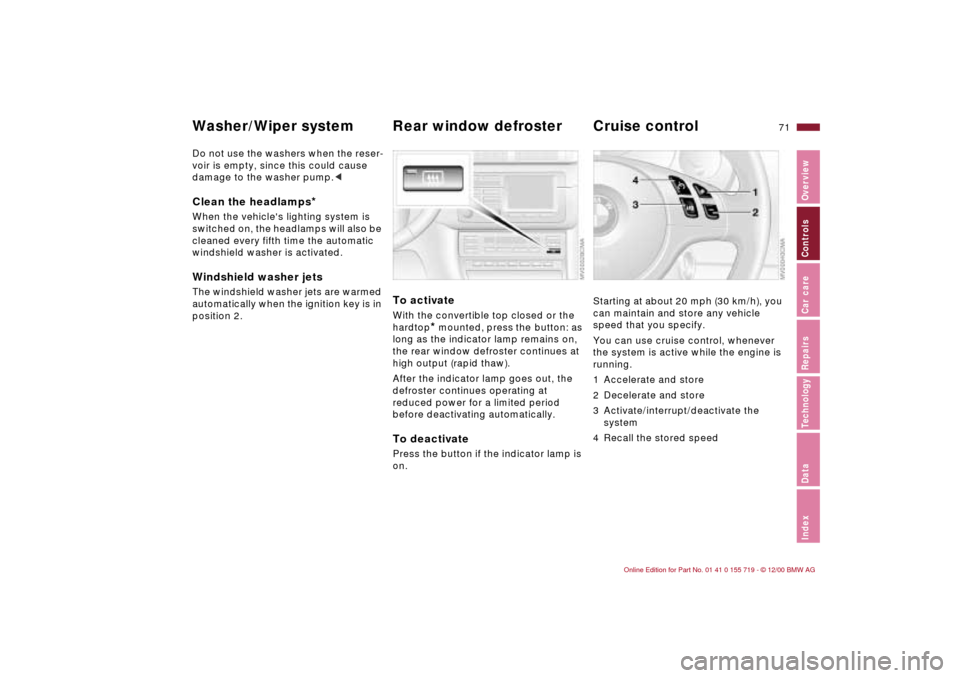
71n
IndexDataTechnologyRepairsCar careControlsOverview
Washer/Wiper system Rear window defroster Cruise control Do not use the washers when the reser-
voir is empty, since this could cause
damage to the washer pump.
When the vehicle's lighting system is
switched on, the headlamps will also be
cleaned every fifth time the automatic
windshield washer is activated.Windshield washer jetsThe windshield washer jets are warmed
automatically when the ignition key is in
position 2.
To activateWith the convertible top closed or the
hardtop
* mounted, press the
button: as
long as the indicator lamp remains on,
the rear window defroster continues at
high output (rapid thaw).
After the indicator lamp goes out, the
defroster continues operating at
reduced power for a limited period
before deactivating automatically.
To deactivatePress the button if the indicator lamp is
on.
Starting at about 20 mph (30 km/h), you
can maintain and store any vehicle
speed that you specify.
You can use cruise control, whenever
the system is active while the engine is
running.
1 Accelerate and store
2 Decelerate and store
3 Activate/interrupt/deactivate the
system
4 Recall the stored speed
Page 72 of 195
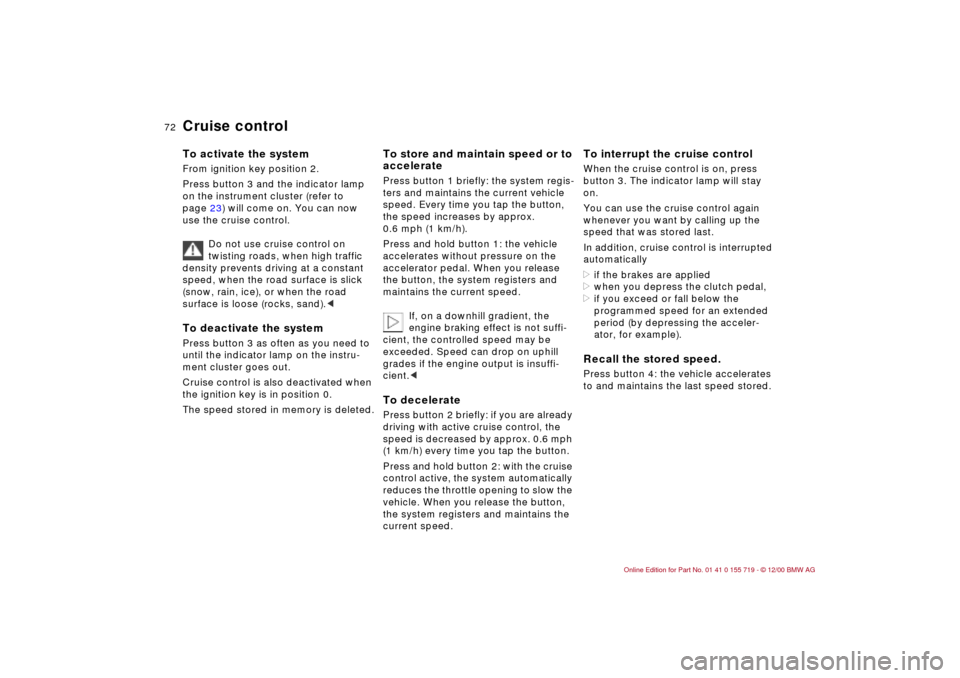
72n
Cruise control To activate the system From ignition key position 2.
Press button 3 and the indicator lamp
on the instrument cluster (refer to
page 23) will come on. You can now
use the cruise control.
Do not use cruise control on
twisting roads, when high traffic
density prevents driving at a constant
speed, when the road surface is slick
(snow, rain, ice), or when the road
surface is loose (rocks, sand).< To deactivate the system Press button 3 as often as you need to
until the indicator lamp on the instru-
ment cluster goes out.
Cruise control is also deactivated when
the ignition key is in position 0.
The speed stored in memory is deleted.
To store and maintain speed or to
acceleratePress button 1 briefly: the system regis-
ters and maintains the current vehicle
speed. Every time you tap the button,
the speed increases by approx.
0.6 mph (1 km/h).
Press and hold button 1: the vehicle
accelerates without pressure on the
accelerator pedal. When you release
the button, the system registers and
maintains the current speed.
If, on a downhill gradient, the
engine braking effect is not suffi-
cient, the controlled speed may be
exceeded. Speed can drop on uphill
grades if the engine output is insuffi-
cient.< To deceleratePress button 2 briefly: if you are already
driving with active cruise control, the
speed is decreased by approx. 0.6 mph
(1 km/h) every time you tap the button.
Press and hold button 2: with the cruise
control active, the system automatically
reduces the throttle opening to slow the
vehicle. When you release the button,
the system registers and maintains the
current speed.
To interrupt the cruise control When the cruise control is on, press
button 3. The indicator lamp will stay
on.
You can use the cruise control again
whenever you want by calling up the
speed that was stored last.
In addition, cruise control is interrupted
automatically
>if the brakes are applied
>when you depress the clutch pedal,
>if you exceed or fall below the
programmed speed for an extended
period (by depressing the acceler-
ator, for example).Recall the stored speed.Press button 4: the vehicle accelerates
to and maintains the last speed stored.
Page 73 of 195
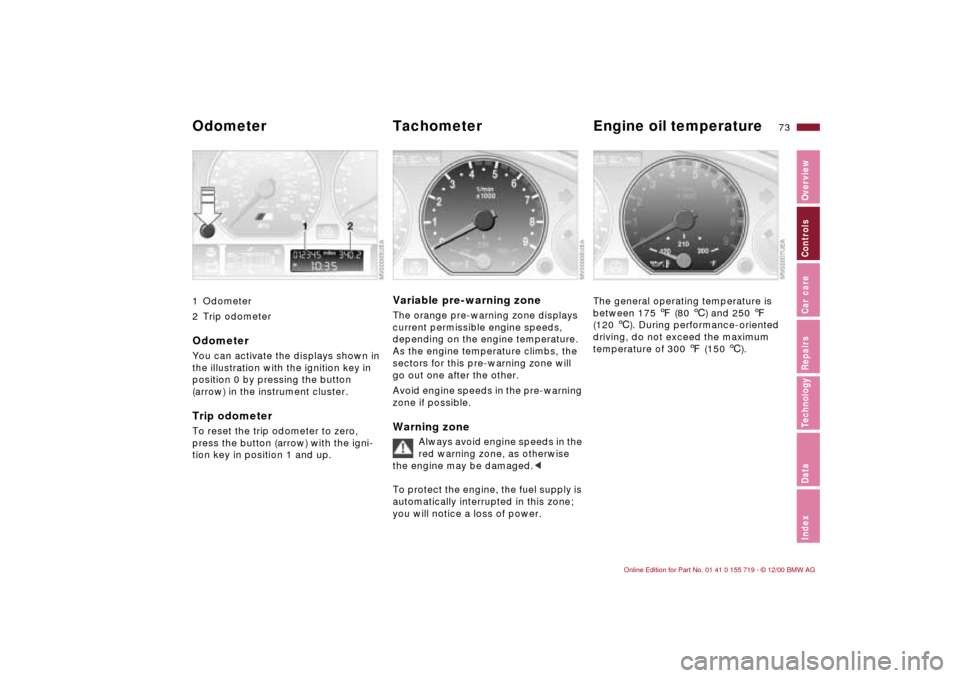
73n
IndexDataTechnologyRepairsCar careControlsOverview
1 Odometer
2 Trip odometerOdometerYou can activate the displays shown in
the illustration with the ignition key in
position 0 by pressing the button
(arrow) in the instrument cluster.Trip odometerTo reset the trip odometer to zero,
press the button (arrow) with the igni-
tion key in position 1 and up.
Variable pre-warning zoneThe orange pre-warning zone displays
current permissible engine speeds,
depending on the engine temperature.
As the engine temperature climbs, the
sectors for this pre-warning zone will
go out one after the other.
Avoid engine speeds in the pre-warning
zone if possible.Warning zone
Always avoid engine speeds in the
red warning zone, as otherwise
the engine may be damaged.<
To protect the engine, the fuel supply is
automatically interrupted in this zone;
you will notice a loss of power.
The general operating temperature is
between 175 7 (80 6) and 250 7
(120 6). During performance-oriented
driving, do not exceed the maximum
temperature of 300 7 (150 6).
Odometer Tachometer Engine oil temperature
Page 74 of 195
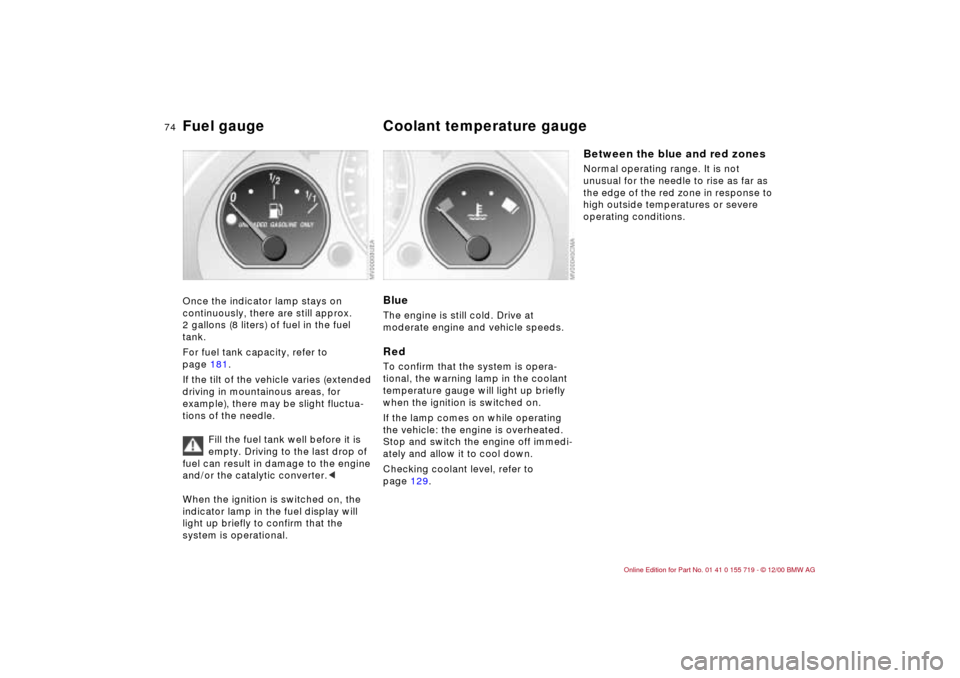
74n
Fuel gauge Coolant temperature gauge Once the indicator lamp stays on
continuously, there are still approx.
2 gallons (8 liters) of fuel in the fuel
tank.
For fuel tank capacity, refer to
page 181.
If the tilt of the vehicle varies (extended
driving in mountainous areas, for
example), there may be slight fluctua-
tions of the needle.
Fill the fuel tank well before it is
empty. Driving to the last drop of
fuel can result in damage to the engine
and/or the catalytic converter.<
When the ignition is switched on, the
indicator lamp in the fuel display will
light up briefly to confirm that the
system is operational.
BlueThe engine is still cold. Drive at
moderate engine and vehicle speeds. RedTo confirm that the system is opera-
tional, the warning lamp in the coolant
temperature gauge will light up briefly
when the ignition is switched on.
If the lamp comes on while operating
the vehicle: the engine is overheated.
Stop and switch the engine off immedi-
ately and allow it to cool down.
Checking coolant level, refer to
page 129.
Between the blue and red zonesNormal operating range. It is not
unusual for the needle to rise as far as
the edge of the red zone in response to
high outside temperatures or severe
operating conditions.
Page 75 of 195
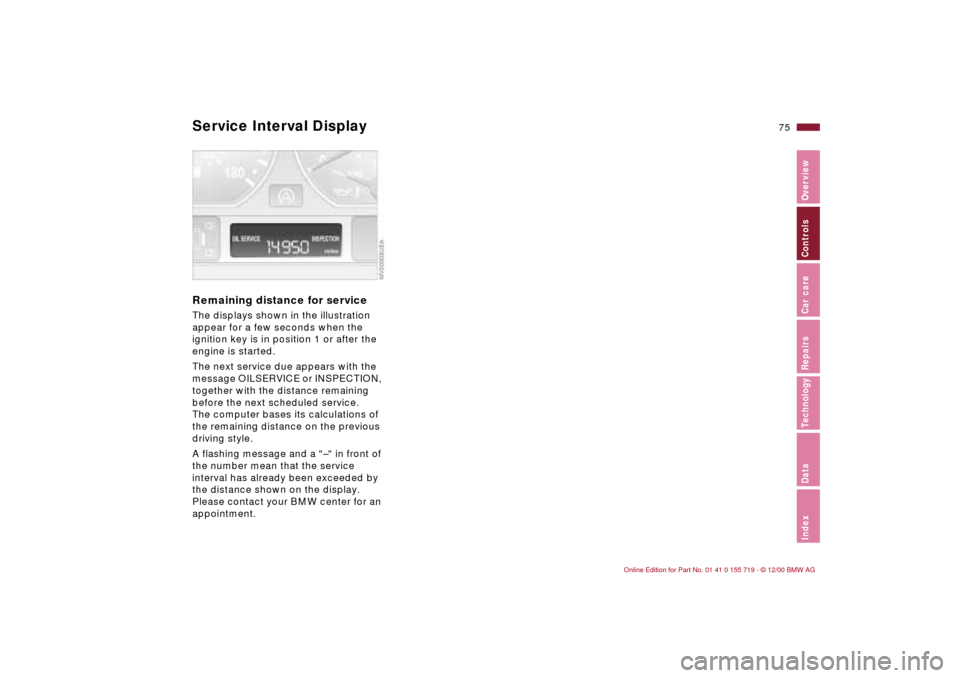
75n
IndexDataTechnologyRepairsCar careControlsOverview
Service Interval Display Remaining distance for serviceThe displays shown in the illustration
appear for a few seconds when the
ignition key is in position 1 or after the
engine is started.
The next service due appears with the
message OILSERVICE or INSPECTION,
together with the distance remaining
before the next scheduled service.
The computer bases its calculations of
the remaining distance on the previous
driving style.
A flashing message and a "–" in front of
the number mean that the service
interval has already been exceeded by
the distance shown on the display.
Please contact your BMW center for an
appointment.
Page 76 of 195
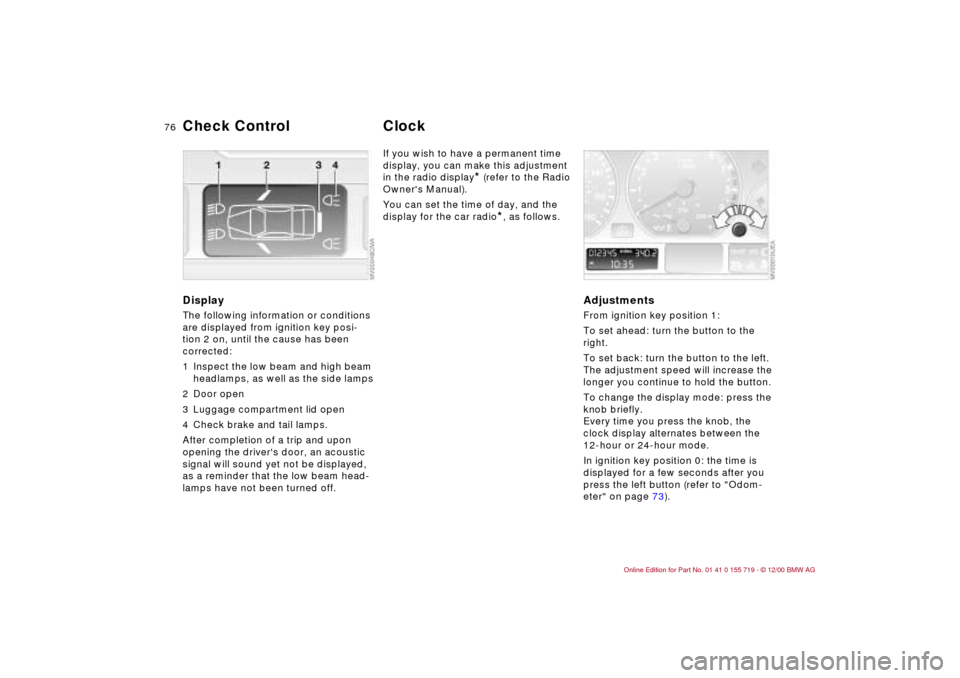
76n
DisplayThe following information or conditions
are displayed from ignition key posi-
tion 2 on, until the cause has been
corrected:
1 Inspect the low beam and high beam
headlamps, as well as the side lamps
2 Door open
3 Luggage compartment lid open
4 Check brake and tail lamps.
After completion of a trip and upon
opening the driver's door, an acoustic
signal will sound yet not be displayed,
as a reminder that the low beam head-
lamps have not been turned off.
If you wish to have a permanent time
display, you can make this adjustment
in the radio display
* (refer to the Radio
Owner's Manual).
You can set the time of day, and the
display for the car radio
*, as follows.
Adjustments From ignition key position 1:
To set ahead: turn the button to the
right.
To set back: turn the button to the left.
The adjustment speed will increase the
longer you continue to hold the button.
To change the display mode: press the
knob briefly.
Every time you press the knob, the
clock display alternates between the
12-hour or 24-hour mode.
In ignition key position 0: the time is
displayed for a few seconds after you
press the left button (refer to "Odom-
eter" on page 73).
Check Control
Clock
Page 77 of 195
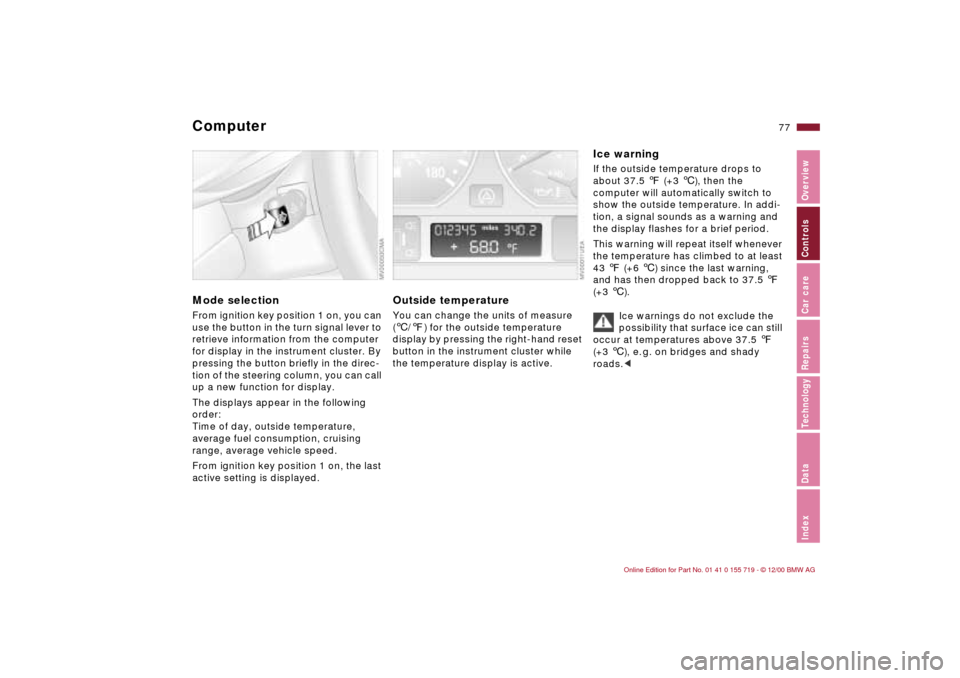
77n
IndexDataTechnologyRepairsCar careControlsOverview
Computer
Mode selectionFrom ignition key position 1 on, you can
use the button in the turn signal lever to
retrieve information from the computer
for display in the instrument cluster. By
pressing the button briefly in the direc-
tion of the steering column, you can call
up a new function for display.
The displays appear in the following
order:
Time of day, outside temperature,
average fuel consumption, cruising
range, average vehicle speed.
From ignition key position 1 on, the last
active setting is displayed.
Outside temperature You can change the units of measure
(6/7) for the outside temperature
display by pressing the right-hand reset
button in the instrument cluster while
the temperature display is active.
Ice warning If the outside temperature drops to
about 37.5 7 (+3 6), then the
computer will automatically switch to
show the outside temperature. In addi-
tion, a signal sounds as a warning and
the display flashes for a brief period.
This warning will repeat itself whenever
the temperature has climbed to at least
43 7 (+6 6) since the last warning,
and has then dropped back to 37.5 7
(+3 6).
Ice warnings do not exclude the
possibility that surface ice can still
occur at temperatures above 37.5 7
(+3 6), e. g. on bridges and shady
roads.<
Page 78 of 195
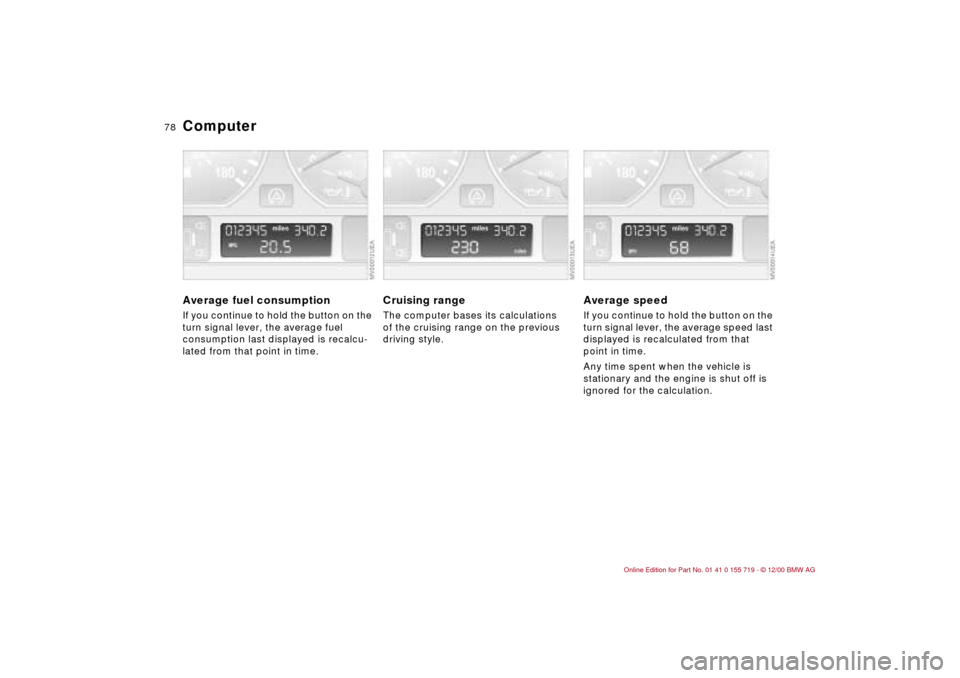
78n
Computer Average fuel consumption If you continue to hold the button on the
turn signal lever, the average fuel
consumption last displayed is recalcu-
lated from that point in time.
Cruising range The computer bases its calculations
of the cruising range on the previous
driving style.
Average speed If you continue to hold the button on the
turn signal lever, the average speed last
displayed is recalculated from that
point in time.
Any time spent when the vehicle is
stationary and the engine is shut off is
ignored for the calculation.
Page 79 of 195

79n
IndexDataTechnologyRepairsCar careControlsOverview
The conceptThe PDC assists you when you back
into a parking space. A signal warns
you of the distance to an obstacle.
To do this, four ultrasonic sensors in
the rear bumper measure the distance
to the nearest object. The range for the
sensors located at both rear corners
ends approx. 2 ft. (60 cm) behind
the bumpers. The range for the two
middle sensors is approx. 4.9 feet
(1.50 meters).
The system is activated automatically
about one second after you engage
reverse with the ignition key in
position 2. PDC is deactivated when
you shift back out of reverse.
Acoustic signalsThe distance to the nearest object is
indicated by a tone sounding at various
intervals. As the distance between
vehicle and object decreases, the inter-
vals between the tones become
shorter. A continuous tone indicates the
presence of an object less than 1 ft.
(30 cm) away.
The warning signal is interrupted after
approx. three seconds if the distance to
the obstacle remains constant during
this time (if you are moving parallel to
a wall, for instance).
System malfunctions will be indicated
by a continuous high-pitched tone
when the system is activated the first
time. Please refer the problem to your
BMW center.The PDC does not remove the
driver's personal responsibility for
evaluating the distance between the
vehicle and any obstacles. Even when
sensors are involved, there is a blind
spot in which objects cannot be
detected. This applies especially in
those cases where the system
approaches the physical limits of ultra-
sonic measurement, as occurs with tow
bars and trailer couplings, and in the
vicinity of thin and painted objects.
Certain sources of sound, such as a
loud radio, could drown out the PDC
signal tone.<
Keep the sensors clean and free
of ice or snow in order to ensure
that they continue to operate effec-
tively.
Do not apply high pressure spray to the
sensors for a prolonged period of time.
Always maintain a distance of more
than 4 in (10 cm).<
Park Distance Control (PDC)
*
Page 80 of 195
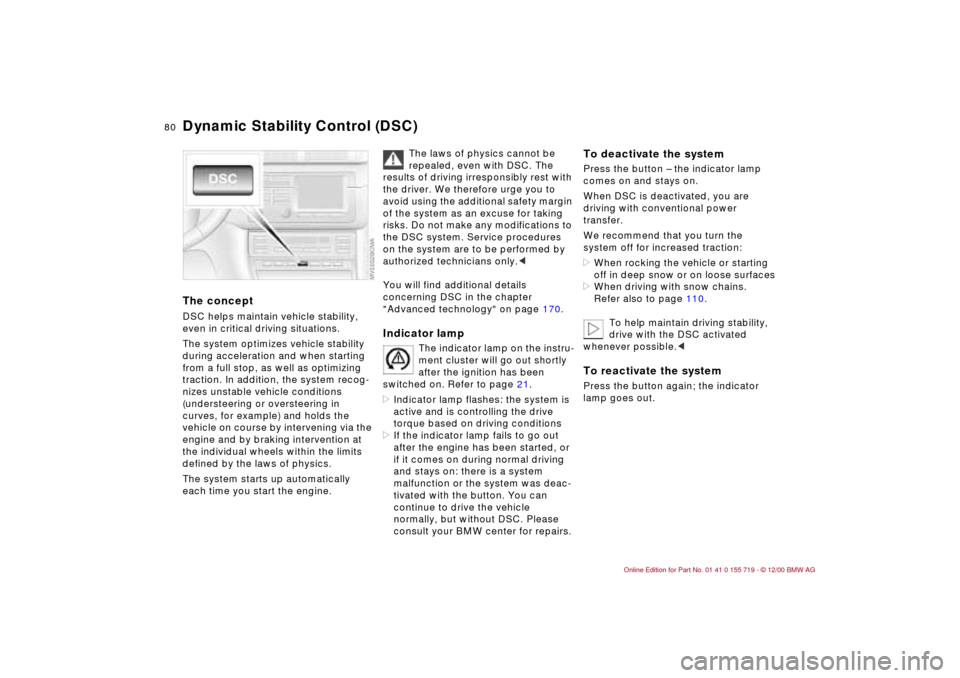
80n
Dynamic Stability Control (DSC)
The concept
DSC helps maintain vehicle stability,
even in critical driving situations.
The system optimizes vehicle stability
during acceleration and when starting
from a full stop, as well as optimizing
traction. In addition, the system recog-
nizes unstable vehicle conditions
(understeering or oversteering in
curves, for example) and holds the
vehicle on course by intervening via the
engine and by braking intervention at
the individual wheels within the limits
defined by the laws of physics.
The system starts up automatically
each time you start the engine.
The laws of physics cannot be
repealed, even with DSC. The
results of driving irresponsibly rest with
the driver. We therefore urge you to
avoid using the additional safety margin
of the system as an excuse for taking
risks. Do not make any modifications to
the DSC system. Service procedures
on the system are to be performed by
authorized technicians only.<
You will find additional details
concerning DSC in the chapter
"Advanced technology" on page 170.
Indicator lamp
The indicator lamp on the instru-
ment cluster will go out shortly
after the ignition has been
switched on. Refer to page 21.
>Indicator lamp flashes: the system is
active and is controlling the drive
torque based on driving conditions
>If the indicator lamp fails to go out
after the engine has been started, or
if it comes on during normal driving
and stays on: there is a system
malfunction or the system was deac-
tivated with the button. You can
continue to drive the vehicle
normally, but without DSC. Please
consult your BMW center for repairs.
To deactivate the systemPress the button – the indicator lamp
comes on and stays on.
When DSC is deactivated, you are
driving with conventional power
transfer.
We recommend that you turn the
system off for increased traction:
>When rocking the vehicle or starting
off in deep snow or on loose surfaces
>When driving with snow chains.
Refer also to page 110.
To help maintain driving stability,
drive with the DSC activated
whenever possible.< To reactivate the systemPress the button again; the indicator
lamp goes out.